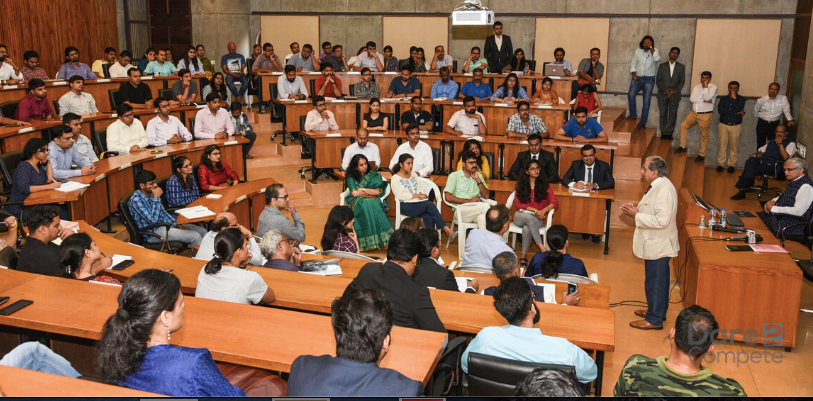Admission Process at IIM A for Candidates for PGP through CAT-2019

In the first step, candidates are short-listed for the Analytical Writing Test (AWT) and Personal Interview (PI) from among the candidates who have a valid CAT-2019 score, who have applied to the programme and who satisfy the eligibility criteria for the admission process at IIM A and the programme described as below.
Shortlisting and selection criteria for PGP 2020-22 batch
Preliminary Screening
According to CAT 2019, based on the previous sections for the admission process at IIM A, candidates who have scored above the minimum cut-offs and the overall percentile rank in addition to having obtained a positive raw score will be considered for the following stages.
Category | Verbal and Reading Comprehension percentile rank (PVRC) | Data Interpretation & Logical Reasoning percentile rank (PDILR) | Quantitative Aptitude percentile rank (PQA) | Overall percentile rank (PT) |
General, EWS | 70 | 70 | 70 | 80 |
NC-OBC-cum-transgender | 65 | 65 | 65 | 75 |
SC | 60 | 60 | 60 | 70 |
ST | 50 | 50 | 50 | 60 |
PwD (General, EWS, NC-OBC-cum-transgender, SC) | 60 | 60 | 60 | 70 |
PwD (ST) | 50 | 50 | 50 | 60 |
The Application Rating (AR) score will be used across different stages. It will be the sum of various rating scores titled 'A', 'B', 'C', and 'D' and numbered tables 2-5.
Table 2: Rating Scores for the 10th Std. Examination (Rating Score A)
| Percent score in 10th Std. Exam | Rating Score A |
<= 55 | 1 |
> 55 and <= 60 | 2 |
> 60 and <= 70 | 3 |
> 70 and <= 80 | 5 |
> 80 and <= 90 | 8 |
> 90 | 10 |
Table 3: Rating Scores for the 12th Std. Examination (Rating Score B)
Science Stream | |
| Percent score in 12th Std. Exam | Rating Score B |
| <= 55 | 1 |
| > 55 and <= 60 | 2 |
| > 60 and <= 70 | 3 |
| > 70 and <= 80 | 5 |
| > 80 and <= 90 | 8 |
| > 90 | 10 |
Commerce Stream | |
| Percent score in 12th Std. Exam | Rating Score B |
| <= 50 | 1 |
| > 50 and <= 55 | 2 |
| > 55 and <= 65 | 3 |
| > 65 and <= 75 | 5 |
| > 75 and <= 90 | 8 |
| > 90 | 10 |
Arts/Humanities Stream | |
| Percent score in 12th Std. Exam | Rating Score B |
| <= 45 | 1 |
| > 45 and <= 50 | 2 |
| > 50 and <= 60 | 3 |
| > 60 and <= 70 | 5 |
| > 70 and <= 85 | 8 |
| > 85 | 10 |
Table 4: Rating Scores for the Bachelor's Degree Examination (Rating Score C)
AC-1 | |
| Percent score in Bachelor's Degree | Rating Score C |
| <= 55 | 1 |
| > 55 and <= 60 | 2 |
| > 60 and <= 62 | 3 |
| > 62 and <= 65 | 5 |
| > 65 and <= 70 | 8 |
| > 70 | 10 |
AC-2 | |
| Percent score in Professional courses | Rating Score C |
| <= 50 | 1 |
| > 50 and <= 53 | 2 |
| > 53 and <= 55 | 3 |
| > 55 and <= 57 | 5 |
| > 57 and <= 63 | 8 |
| > 63 | 10 |
AC-3 | |
| Percent score in Bachelor's Degree | Rating Score C |
| <= 55 | 1 |
| > 55 and <= 60 | 2 |
| > 60 and <= 65 | 3 |
| > 65 and <= 70 | 5 |
| > 70 and <= 80 | 8 |
| > 80 | 10 |
| AC - 4 & AC - 6 | |
| Percent score in Bachelor's Degree | Rating Score C |
| <= 60 | 1 |
| > 60 and <= 65 | 2 |
| > 65 and <= 70 | 3 |
| > 70 and <= 75 | 5 |
| > 75 and <= 85 | 8 |
| 10 | |
AC-5 | |
| Percent score in Professional courses | Rating Score C |
| <= 50 | 1 |
| > 50 and <= 55 | 2 |
| > 55 and <= 60 | 3 |
| > 60 and <= 65 | 5 |
| > 65 and <= 75 | 8 |
| > 75 | 10 |
Table 5: Rating Scores for Work Experience (Rating Score D)
| Work Experience in Month (as on July 31, 2019) | Rating Score D |
< 12 months | 0 |
>= 12 and <= 36 months | MF * (number of months of work experience – 11) |
> 36 months | 5 |
| Work-experience Multiplication Factor (MF) = 0.20 | |
Application Rating Score: AR = (A+B+C+D)
Normalised AR score of an applicant is equal to their AR score divided by the average of the top 50 AR scores from the applicants' pool, (the applicants' pool, in this case, is defined as the group of candidates who appear for CAT-2019 and apply for the admission process at IIMA.)
Shortlisting for Analytical Writing Test (AWT) & Personal Interview (PI)
This will be a dual-stage process.
Stage 1: From the Applicants' pool: Selection of exceptional performers across different disciplines
Top candidates from each academic discipline will be shortlisted for AWT & PI based on their Composite Score (CS), given below, which is subject to their fulfilling of the criteria C1-C3.
The number of candidates selected from each of the academic categories (AC), from SC/ST/NC-OBC/PwD categories are at least 100. The top 5% in the respective AC are limited to the respective categories of General/SC/ST/NC-OBC/PwD from the candidates that appeared for CAT 2019. Also known as the ACRC groups, (subject to upper limits on the numbers per ACRC group as specified in Table 6), the candidates will be shortlisted for AWT & PI on the basis of the composite score ‘CS' (see below) subject to their fulfilling of the criteria C1-C3.
| CS (Composite Score) = ARF_CS * Normalised AR score + CATF_CS * Normalised overall score in CAT-2019 |
| Application Rating Multiplication Factor for Composite Score (ARF_CS) = 0.35; CAT Multiplication Factor for Composite Score (CATF_CS) = 0.65 |
Table 6a: The upper limits (UL) on the number of candidates to be shortlisted per RC for AC-1, AC-2, AC-3, AC-5
Category | Upper Limit (UL) Per ACRC[1] |
General | 100 |
NC-OBC-cum-transgender | 57 |
SC | 32 |
ST | 16 |
PwD | 6 |
Table 6b : The upper limits (UL) on the number of candidates to be shortlisted per RC for AC-4
| Category | Upper Limit (UL) Per ACRC[2] |
| General | 150 |
| NC-OBC-cum-transgender | 85 |
| SC | 48 |
| ST | 24 |
| PwD | 9 |
- 5% or the numbers given in Table 6a, whichever is smaller.
- 5% or the numbers given in Table 6b, whichever is smaller.
Criteria C1 - C3:
C1. PVRC, PDILR, PQA and PT must not be lower than the minimum cut-offs as specified in Table 1.
C2. P ≥ Minimum cut-offs (specific to the category and the stream as shown in Table 7), where P is the average of the percentages of marks scored in 10th and 12th std. examinations.
Table 7: Minimum cut-off for P across different disciplines and different categories
Stream in 12th std. | General-cum-EWS Category | NC-OBC-cum-transgender Category | SC Category | ST Category | PWD (General, NC-OBC-cum-transgender, SC) | PWD (ST) |
| Science | 80 | 75 | 70 | 65 | 70 | 65 |
| Commerce | 77 | 72 | 67 | 62 | 67 | 62 |
| Arts & Humanities | 75 | 70 | 64 | 59 | 64 | 59 |
C3. (Percentage of marks in the bachelor's examination) ≥ Minimum cut-off percentage to be set at the 80th percentile of the percentage of marks of the respective ACRC group of the applicantsट pool, (the applicants' pool in this case being defined as the group of candidates who appear for CAT-2019, apply to the admission process at IIMA and belong to the respective ACRC.)
Any AC, for which the total number of applicants to IIM A who appear for CAT-2019 from SC/ST/NC-OBC/PwD categories is less than 100, will not be subdivided into ACRCs as above. For such an AC, the top 100 or the top 5% in the respective AC among all the applicants to IIM A who appear for CAT-2019, whichever is less, will be shortlisted for AWT & PI on the basis of the composite score ‘CS' (see above) subject to their fulfilling of the criteria C4-C6.
Criteria C4 - C6:
C4. PT ≥ 80, PQA ≥ 70, PDILR ≥ 70 and PVRC ≥ 70.
C5. P ≥ 80 (Science), 77 (Commerce), 75 (Arts/Humanities), where P is the average of the percentages of marks scored in the 10th and 12th std. examinations.
C6. (Percentage of marks in the bachelor's examination) ≥ Minimum cut-off percentage, to be set at the 80th percentile of the percentage of marks of the respective AC group of the applicants' pool, (the applicants' pool in this case being defined as the group of candidates who appear for CAT-2019, apply to admission process at IIM A and belong to the respective AC.)
Stage 2: After removing the candidates selected in Stage 1 from each category (General, NC-OBC, SC, ST and PWD) the additional number of candidates to be shortlisted for AWT & PI will be selected on the basis of the composite score ‘CS' (see above) subject to their fulfilling criteria C1-C2.
3. Final Selection
Selection at this stage will strictly be based on the shortlisting of the candidates who apply for the admission process at IIM A done separately for each category (General/SC/ST/NC-OBC/PwD) on the basis of their ‘Final Composite Score's (FCS). The numbers selected in different reservation categories will be in proportions mandated by law.
The FCS of a candidate who appears in AWT & PI will be computed as follows:
FCS = PIF * Normalised PI Score + AWTF * Normalised AWT Score + CATF_FCS * Normalised CAT Score + ARF_FCS * AR |
| Personal Interview Multiplication Factor (PIF) = 0.50 AWT Multiplication Factor (AWTF) = 0.10 CAT Score Multiplication Factor for Final Composite Score (CATF_FCS) = 0.25 Application Rating Multiplication Factor for Final Composite Score (ARF_FCS) = 0.15 |
The normalised PI and AWT scores of a candidate are their scores in the respective field divided by the average of the top 1% scores in the same field respectively.
The following information is about the admission process at IIM A for its PGP subsequent to CAT. It is therefore, important for candidates to read them carefully.
- In addition to the performance in CAT, IIM A uses the academic performance of candidates throughout their academic career up to the bachelor's level for shortlisting for AWT & PI.
- Please note that IIM A shortlists candidates for AWT & PI independent of the other IIMs. Hence, it is possible to observe variations in the lists of the candidates shortlisted by different IIMs.
- Details of the candidates shortlisted will be made available on the IIM A website (www.iima.ac.in) tentatively by the second week of January 2020 after the CAT results are published. Shortlisted candidates would also be sent AWT & PI call letters by IIM A.
- After the AWT & PI round, admission offers are made by IIM A to successful candidates. The final selection is based on a diverse set of attributes which includes performance in CAT, performance in AWT & PI, academic, co-curricular and extra-curricular achievements, work experience, etc. All selected candidates for the IIMA 2-year PGP must be 19 years of age as on June 30, 2020.
- Disclosure of information about the admission process is driven by concerns which at times conflict with each other. The admission process at IIM A will be transparent. IIM A exercises its own discretion in disclosing weights assigned to diverse sets of attributes mentioned under paragraph 4 above.
- Candidates, who appear in AWT & PI will be able to view whether they have been offered admission by IIM A tentatively during the second week of April 2020 by visiting the IIM A website. Admission offer letter would be sent to all successful candidates. Candidates, who are offered admission, need to confirm their acceptance by completing all the required formalities by the first/second week of May 2020. Some candidates may also be placed on the waiting list initially during the second week of April 2020.
Table 8: Categories for bachelor's degree/integrated master's degree (as per CAT Application)
| AC-1 (Medicine and Surgery based subjects): MBBS, MD (USA). |
| AC-2 (Selected Professional Degrees): Chartered Accountancy (CA), Cost and Works Accountancy (ICWA), Company Secretaryship (CS). |
| AC-3 (All Commerce, Economics, Finance and Management Related Degrees): Including BAF, BBA, BBE, BBI, BBM, BBS, BCAF, BCCA, BCOM, BFIA, BFM, BHM, BHMCT, BIBF, BMS (Bachelor of Management studies) and BSBA degrees. In particular, including:
|
AC-4
In particular, including:
In particular, including
|
| AC-5 (All Arts/Humanities Related Degrees, Design, Education, Fashion Design/Technology, Law and Rural Studies): Including any BA (excluding Economics, Geography and Geological Sciences, Mathematics and Statistics), BAA, BAJM, BCJ, BDES, BED, BFTECH, BJ, BJMC, BL, BM (Bachelor of Music), BMC, BMM, BMus, BSW and LLB. In particular, including
|
| AC-6: Any other discipline not mentioned in AC-1 to AC-5. |
Login to continue reading
And access exclusive content, personalized recommendations, and career-boosting opportunities.
















Comments
Add comment